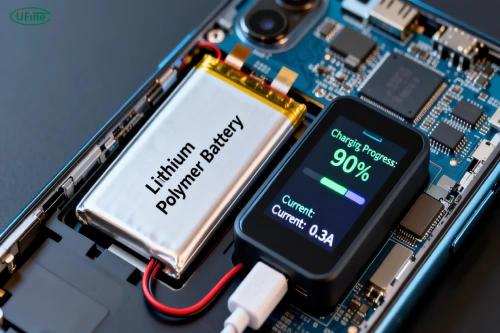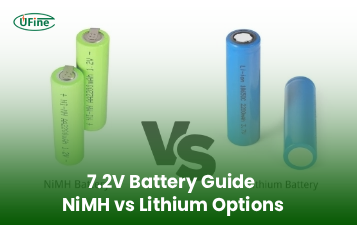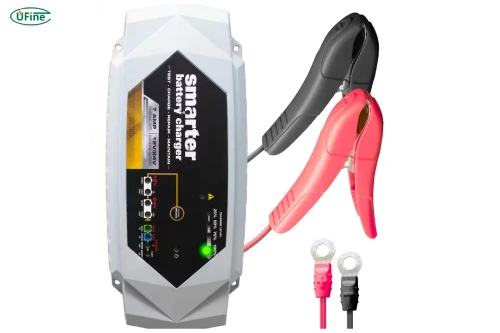
- Part 1. What is a smart charger?
- Part 2. How does a smart charger work?
- Part 3. What is smart charging?
- Part 4. Is smart charging good for batteries?
- Part 5. How to use a smart charger correctly
- Part 6. Will a smart battery charger charge a dead battery?
- Part 7. Key features of smart chargers
- Part 8. Smart chargers vs. traditional chargers
- Part 9. Benefits
- Part 10. Applications
- Part 11. How to choose the right smart charger
- Part 12. Maintenance and safety tips
- Part 13. FAQ
Part 1. What is a smart charger?
A smart charger is an advanced device designed to charge batteries more intelligently than traditional chargers. Unlike conventional chargers that deliver a fixed voltage or current until a battery is “full,” smart chargers monitor battery voltage, temperature, and state of charge. They adjust the charging rate dynamically to prevent damage, optimize charging speed, and prolong battery life.
Smart chargers are widely used in lithium-ion batteries for smartphones, e-bikes, and power tools, as well as in lead-acid batteries for vehicles and solar energy systems.
Part 2. How does a smart charger work?

The core of a smart charger is a microprocessor or control chip that continuously monitors the battery’s condition. Key functions include:
- Voltage monitoring: Ensures the battery is not overcharged or undercharged.
- Current regulation: Adjusts current to match the battery’s capacity and chemistry.
- Temperature monitoring: Prevents overheating, which can degrade or damage the battery.
- Multi-stage charging: Many smart chargers employ stages such as pre-charge, bulk charge, absorption, and float maintenance to optimize battery health.
This intelligent control allows the charger to adapt to the battery’s real-time needs, unlike traditional chargers, which cannot respond to changing conditions.
Part 3. What is smart charging?
Smart charging refers to a controlled process where a battery’s charging parameters adapt dynamically to preserve performance and longevity. It is particularly important for:
- Lithium-ion batteries, which are sensitive to voltage and temperature fluctuations.
- NiMH batteries, which can be overcharged if not monitored.
- Lead-acid batteries, where proper absorption and float stages prevent sulfation.
Smart charging combines algorithms, sensors, and real-time monitoring to ensure the battery receives the optimal current and voltage at each stage of charging.
Part 4. Is smart charging good for batteries?
Absolutely. Smart charging offers multiple benefits that traditional charging methods cannot match:
- Prevents overcharging: Overcharging reduces capacity and may damage internal chemistry. Smart chargers automatically stop or reduce current when full.
- Minimizes heat buildup: Excess heat accelerates battery degradation. Temperature sensors in smart chargers help maintain safe thermal levels.
- Extends battery lifespan: By regulating current and voltage intelligently, smart chargers reduce chemical stress, allowing batteries to last longer.
- Improves performance: Batteries charged properly maintain more consistent voltage and energy output.
- Supports multiple chemistries: Modern chargers automatically detect the battery type and adjust charging protocols accordingly.
Part 5. How to use a smart charger correctly
Using a smart charger properly is crucial for safety and efficiency. Follow these steps:
- Check compatibility: Ensure the charger matches the battery’s voltage and chemistry.
- Inspect battery condition: Avoid charging damaged or leaking batteries.
- Connect correctly: Attach terminals according to polarity; most smart chargers include reverse-polarity protection.
- Select the charging mode: Some chargers allow manual selection; others automatically detect the battery type.
- Monitor the charging process: While smart chargers operate automatically, it’s good practice to occasionally check the battery and charger.
- Complete the charging cycle: Let the charger finish all stages, including trickle or float maintenance if available.
- Store properly after charging: Remove the battery or charger from heat and moisture.
Following these steps ensures maximum efficiency, safety, and lifespan for your batteries.
Part 6. Will a smart battery charger charge a dead battery?
Smart chargers are designed to revive batteries with low voltage, but there are limits:
- Most smart chargers can detect batteries with voltages slightly below normal. They may enter a “pre-charge” or “boost” mode to bring the battery to a safe level.
- If a battery is completely dead, damaged, or chemically deteriorated, the charger may fail to detect it. Attempting to charge such batteries can be unsafe.
- Some advanced smart chargers, including reconditioning modes that attempt to restore slightly discharged batteries safely.
In general, smart chargers can recharge low batteries effectively, but they cannot restore severely damaged or old cells.
Part 7. Key features of smart chargers
Smart chargers have several distinguishing features:
- Automatic shutoff: Stops charging when the battery is full to prevent overcharging.
- Reverse polarity protection: Avoids damage if terminals are connected incorrectly.
- Temperature monitoring: Prevents overheating during high-current charging.
- Multi-chemistry support: Charges lithium-ion, NiMH, lead-acid, and other chemistries.
- Digital displays or LED indicators: Show real-time charging status, voltage, and battery health.
- Maintenance/trickle charge: Keeps batteries topped off without overcharging for long-term storage.
These features make smart chargers safer, more efficient, and more user-friendly than conventional chargers.
Part 8. Smart chargers vs. traditional chargers
Here’s a comparison to highlight why smart chargers are superior:
| Feature | Traditional Charger | Smart Charger |
|---|---|---|
| Charging rate | Fixed | Adaptive based on battery condition |
| Overcharge protection | Rare | Automatic shutoff |
| Battery lifespan | Reduced | Extended |
| Monitoring | None | Voltage, current, temperature |
| Multi-chemistry support | Limited | Broad support (Li-ion, NiMH, lead-acid) |
| Maintenance mode | No | Yes, float/trickle charge |
Smart chargers save energy, reduce user intervention, and significantly reduce the risk of battery damage, making them a better choice for modern devices.
Part 9. Benefits
Smart chargers offer a combination of efficiency, safety, and performance benefits:
- Longer battery lifespan: Intelligent charging reduces stress on the battery’s internal chemistry.
- Faster and safer charging: Adjusts current to the battery’s needs, avoiding overheating.
- Reduced energy waste: Automatically stops charging, minimizing electricity use.
- Less maintenance: Float or trickle charging keeps batteries ready for use without overcharging.
- Versatility: Works across battery types and sizes, including custom lithium packs from Ufine Battery.
Part 10. Applications
Smart chargers are widely used across multiple sectors:
- Electric vehicles (EVs) and e-bikes: Ensures efficient battery management and prolongs lifespan.
- Power tools: Maintains lithium-ion and NiMH packs for consistent performance.
- Marine and RV applications: Keeps lead-acid batteries topped off safely.
- Consumer electronics: Smartphones, laptops, drones, and other portable devices benefit from controlled charging.
- Industrial and medical equipment: Critical for devices where battery failure is not an option.
Part 11. How to choose the right smart charger
Selecting the correct smart charger ensures safety and efficiency:
- Check compatibility: Voltage and chemistry must match the battery.
- Consider charging speed: High-current fast chargers are convenient but may shorten battery lifespan if used frequently.
- Look for protection features: Overcurrent, overvoltage, and thermal monitoring are essential.
- Certification: Choose chargers that meet safety standards (UL, CE, RoHS).
- Brand reliability: Trusted manufacturers like Ufine Battery provide chargers specifically designed for our battery packs, ensuring optimal performance.
Part 12. Maintenance and safety tips
Even smart chargers require careful handling:
- Keep terminals clean and dry to avoid poor connections.
- Avoid charging in extreme temperatures; optimal range is usually 10–30°C.
- Inspect cables and connectors regularly for wear or corrosion.
- Use the correct charging mode; avoid forcing a high-current charge on batteries not rated for it.
Proper use and maintenance maximize both battery and charger lifespan.
Part 13. FAQ
Can I leave a smart charger plugged in overnight?
Yes. Smart chargers automatically stop charging or switch to maintenance mode, making overnight charging safe.
Are smart chargers safe for lithium-ion batteries?
Yes. They monitor voltage and temperature to prevent overcharging and overheating, which is critical for lithium-ion battery safety.
How long does it take to charge a battery with a smart charger?
Charging time depends on battery capacity and charger output. Small batteries may take 1–3 hours, while larger EV or lithium packs may require 5–12 hours.
Do smart chargers work with all battery types?
Most smart chargers support lithium-ion, NiMH, and lead-acid batteries, but always check manufacturer specifications.
What should I do if my smart charger doesn’t recognize a battery?
Ensure the battery is not completely dead, inspect terminals for corrosion, and verify compatibility. Some chargers also have a “boost” or pre-charge mode for low-voltage batteries.
Related Tags:
More Articles

NiMH vs Lithium 7.2V Battery and Charger: Which Is Better?
Compare 7.2V NiMH vs Lithium batteries and chargers in 2025. Learn runtime, weight, charging, lifespan, and cost to choose the best for your device.
How to Choose the Right 7.2V Battery and Charger for Your Device?
Learn how to choose the right 7.2V battery and charger for optimal performance, safety, and longevity across RC, tools, medical, and industrial devices.
Big Square Battery Safety Standards You Must Know
Learn key safety standards for big square batteries to avoid fire risks, shipping delays, and compliance issues in EV, industrial, and energy storage projects.
Big Square Battery Applications in Solar & Industrial Equipment
Big square batteries deliver high capacity, stable output, and long life for solar, industrial, and backup power. Explore key uses and advantages.
Big Square Battery vs Cylindrical Battery: Complete 2025 Guide for EVs, ESS & Industrial Devices
Choosing the right battery is key for designers and engineers. Compare big square vs cylindrical batteries to find the best fit for your application.



